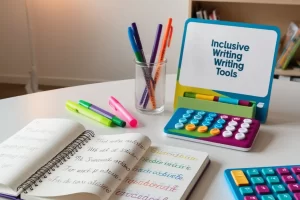Imagine the frustration of a child who has thoughts and feelings to share but cannot find the words to express them. For many nonverbal children, this is a daily reality. Communication is one of the most fundamental skills for human interaction, and when it is limited, the impact on emotional and social development can be profound.
Finding alternative forms of expression, therefore, becomes a priority—not only to improve these children’s quality of life but also to strengthen their connections with the world around them. Handwriting, often seen merely as an academic technique, can transform into a powerful tool in this process.
More than just teaching how to write, it offers a way to externalize thoughts, feelings, and even desires that might otherwise remain silent. Handwriting can be an accessible and rich means of expression, providing these children with a way to “speak” without words. In this article, we will explore how handwriting can be adapted to become an essential communication tool for nonverbal children.
1- Handwriting as Personal Expression
Handwriting provides a unique way for nonverbal children to communicate, allowing them to express feelings, desires, and thoughts without relying on speech. Through manual writing, they can share their ideas in an accessible and effective way, creating an extension of verbal communication. Handwriting, therefore, offers a new way to “speak” without words, expanding the possibilities for interaction with the world around them.
How handwriting enhances verbal communication:
- Writing allows children to externalize their ideas through letters, drawings, or symbols.
- With handwriting, children can share emotions and needs, establishing a more direct connection with others.
- Writing does not depend on speech, making it an essential tool for those facing verbal communication difficulties.
Emotional benefits of handwriting:
- Self-confidence: Writing helps children develop self-esteem by realizing they can express themselves.
- Sense of control: Writing gives children control over how they communicate, empowering them.
- Emotional expression: Handwriting serves as a way to release emotions, especially when verbal communication is limited.
Examples of simple methods for beginners:
- Basic strokes: Starting with lines, curves, and circles helps children develop motor control.
- Geometric shapes: Introducing shapes like squares and triangles can evolve into letters and symbols.
- Creative drawings: Allowing children to draw with the strokes and shapes they’ve learned makes the process more fun and expressive.
These activities, when done playfully, help children realize they can communicate in a personal and unique way without needing words. By adopting handwriting as a tool for expression, the child gains a new “voice.”
2- Adapted Handwriting Tools and Techniques
For handwriting to be effective as a communication tool for nonverbal children, it is crucial to adapt materials and techniques according to each child’s specific needs. Choosing the right materials and applying appropriate strategies can optimize the learning and expression process.
Use of specific materials:
- Ergonomic pens and pencils: Tools with thicker or anatomically designed grips help children with motor difficulties hold them more comfortably.
- Soft-tip pencils or ink: For children who struggle with pressure application, these materials make control easier and create lighter strokes.
- Papers with different textures: Thicker or softer-textured papers help children feel the pen while writing, making movement more intuitive.
- Guided-line papers: Using paper with reference lines or shapes aids in letter alignment and formation.
Adapted handwriting for special needs:
- Assistive tools: Pens with grips or writing control devices help children with severe motor difficulties maintain movement control.
- Pressure adjustment: For children unable to control pressure, using materials that allow softer writing can be helpful.
- Gradual exercises: Starting with simple shapes and gradually increasing complexity helps build confidence and coordination.
Practical activities and exercise examples:
- Letter and shape drawing: Beginning with simple shapes, like circles, and progressing to letters familiarizes children with writing control.
- Writing simple words: Introducing meaningful words, such as family members’ names, reinforces the emotional connection to writing.
- Free drawing: Encouraging free drawing allows children to express themselves creatively, reinforcing writing as a personal communication tool.
- Writing activities with images: Associating words with images or pictograms aids comprehension and makes learning more visual.
These adapted tools and activities make handwriting a powerful form of communication for nonverbal children, providing an accessible way to express themselves and interact with the world.
3- How Handwriting Can Be Integrated with Other Communication Strategies
When combined with other forms of communication, handwriting can further enhance nonverbal children’s ability to express themselves. By integrating different strategies, such as visual communication and assistive technology, it is possible to create a more accessible and inclusive environment. This collaborative approach facilitates understanding and expands communication options, promoting richer and more multifaceted expression.
Combination with visual communication:
Visual communication is a powerful tool when combined with handwriting, especially for children who find images easier to understand than written words. Incorporating pictograms, icons, and images alongside handwriting can significantly improve comprehension and information retention.
- Pictograms and icons: Using simple symbols helps children associate writing with objects, actions, or specific feelings. For example, an image of an apple next to the word “apple” can help the child understand and remember what they are writing.
- Communication cards: Combining handwriting with cards that contain images and words allows children to use them to form simple sentences and communicate needs more directly and effectively.
- Visual stories: Creating small visual narratives where written words are accompanied by illustrations makes communication more accessible and comprehensible.
Assistive technology and handwriting:
Assistive technology has played a growing role in the inclusion of children with special needs. When applied to handwriting, it can open new communication possibilities. Digital tools can help enhance manual writing and promote more fluid and accessible communication.
- Tablets and touch devices: Digital devices with touch screens can be used for interactive handwriting practice. Apps that allow children to write on the screen help develop fine motor skills and provide immediate visual feedback.
- Adaptive writing software: Various software programs support children with motor difficulties by adjusting touch sensitivity or assisting in letter and word formation.
- Text-to-speech devices: For children not yet fluent in writing, text-to-speech devices can read aloud what has been written, offering immediate feedback and encouraging communication.
Integration into educational environments:
Teachers and therapists play a key role in integrating handwriting with other communication strategies in educational settings. By adapting the curriculum and creating an inclusive environment, they can help children express themselves more effectively.
- Use of adapted handwriting in the classroom: Educators can include adapted handwriting exercises in daily activities, promoting writing as a communication tool.
- Enriched learning environments: Classrooms can be equipped with materials that encourage handwriting, such as large-lined paper, ergonomic pens, and dedicated writing spaces.
Integrating handwriting with other communication strategies not only facilitates expression for nonverbal children but also creates a more inclusive and dynamic learning environment. The combination of different methods and technologies offers new opportunities for children to communicate more completely and effectively, promoting emotional and social development.
Final Considerations
Handwriting emerges as a powerful communication tool for nonverbal children, offering an accessible and effective means of expression. By adapting handwriting materials and techniques, it is possible to meet each child’s individual needs, providing an alternative way to “speak” without words.
Moreover, emotional benefits such as increased self-confidence and a sense of control are essential for a child’s development, helping them express feelings and needs more directly.
Personalized approaches, through specific materials and playful activities, make handwriting an enjoyable and engaging experience. Whether through ergonomic tools, guided paper, or gradual exercises, each adaptation step contributes to more effective learning. By integrating manual writing with creative expression, children can explore their emotions and strengthen their communication with the world.




